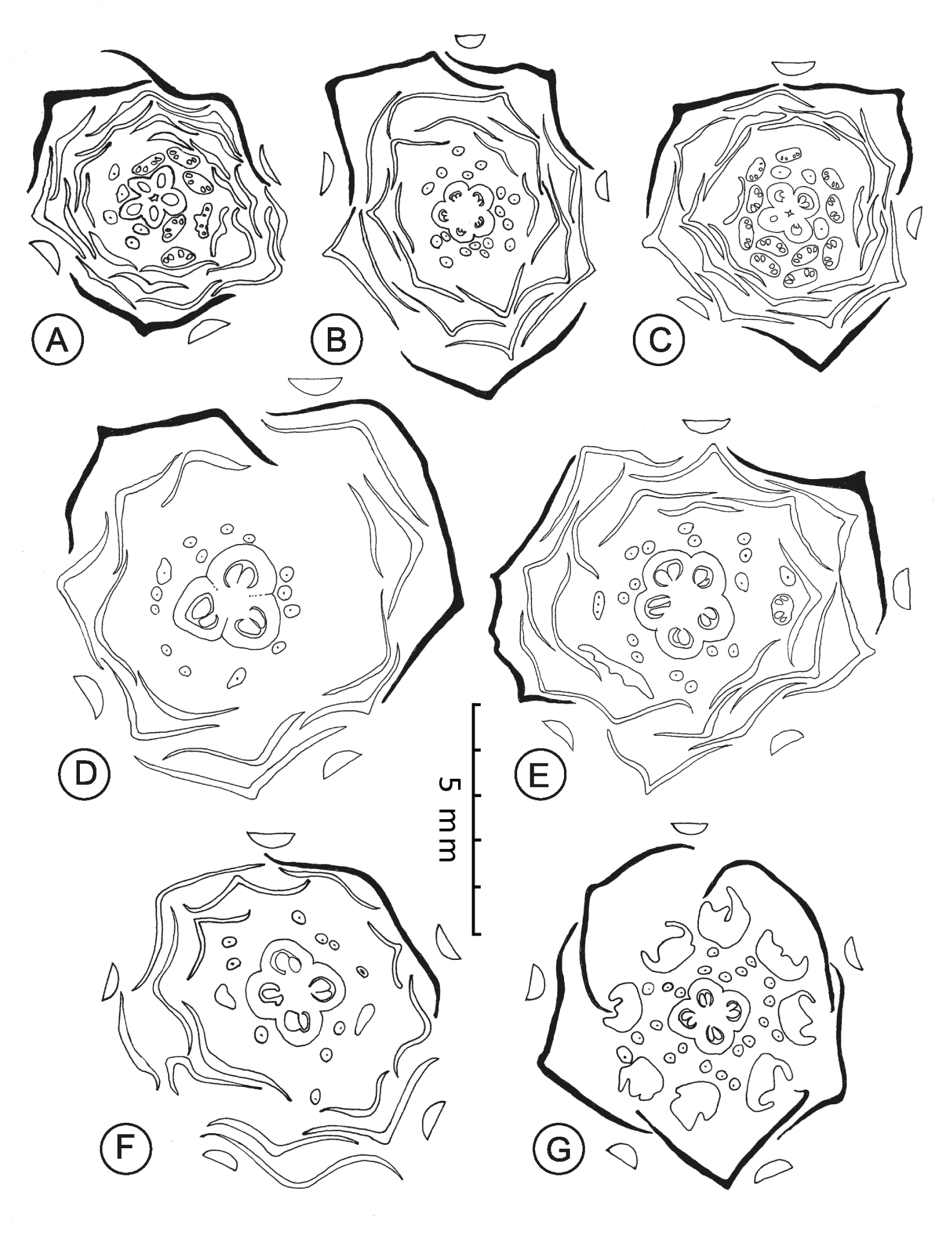Floral vascular patterns of the double-flowered and wild-type morphs of Nigella damascena L. (Ranunculaceae)
Abstract
The perianth of the double-flowered morph of Nigella damascena L. consists of spirally inserted petaloid sepals and sepal-like organs, similar in shape and colour to the petaloid sepals of the wild-type flower. It is devoid of petals. We compare the vascularization of each organ category of the double flower with that of the wild-type. We show that the vascular patterns of the sepal-like organs and of the petals are identical, and found an inverse relationship between the number of bracts and the number of sepals in the double-flowered morph. These two surprising findings will influence the future evo-devo studies on this plant model.
References
Blaringhem L. 1910. Sur une forme nouvelle de Nigelle, Nigella damascena polycephala, obtenue après une mutilation. C.R. Hebd. Séances Acad. Sci. 150: 406–408.
Brouland M. 1935. Recherches sur l’anatomie florale des Renonculacées. Thesis, Sér. A, n°1548, n° d’ordre 2414. Jouve, Paris.
Clusius C. 1601. Rariorum plantarum historia. Officina plantiniana apud J. Moretum, Antwerp.
Gerlach D. 1984. Botanische Mikrotechnik. 3d ed. Thieme, Stuttgart.
Gonçalves B., Nougué O., Jabbour F., Ridel C., Morin H., Laufs P., Manicacci D., Damerval C. 2013. An APETALA3 homolog controls both petal identity and floral meristem patterning in Nigella damascena L. (Ranunculaceae). Plant J. 76 (2): 223–235.
Hoffmann H. 1875. Nigella damascena L. In: Hoffmann H. (ed.), Zur Speciesfrage: 39–43. De Erven Loosjes, Haarlem.
Jabbour F., Ronse De Craene L., Nadot S., Damerval C. 2009. Establishment of zygomorphy on an ontogenic spiral and evolution of perianth in the tribe Delphinieae (Ranunculaceae). Ann. Bot. 104: 809–822.
Jabbour F., Udron M., Le Guilloux M., Gonçalves B., Manicacci D., Nadot S., Damerval C. In press. Flower development schedule and AGAMOUS-like gene expression patterns in two morphs of Nigella damascena L. (Ranunculaceae) differing in floral architecture. Bot. J. Linn. Soc.
Linnaeus C., von. 1753. Nigella. In: Species plantarum, t. I: 534. Laurentius Salvius, Stockholm.
Novikoff A.V., Jabbour F. 2014. Floral anatomy of Delphinieae (Ranunculaceae): Comparing flower organization and vascular patterns. Mod. Phytomorphol. 5: 35–44.
Payer J.-B. 1857. Traité d’organogénie comparée de la fleur. Section des nigelles – Delphinium, Aconitum: 247–252. Masson, Paris.
Ronse De Craene L., Iwamoto A., Bull-Hereñu K., Dos Santos P., Luna J.A., Farrar J. 2014. Understanding the structure of flowers – The wonderful tool of floral formulae: A response to Prenner & al. Taxon 63 (5): 1103–1111.
Smith J.H. 1928. Vascular anatomy of ranalian flowers. I. Ranunculaceae. Bot. Gaz. 82 (1): 1–29.
Toxopéus H.J. 1927. Erblichkeitsuntersuchungen an Nigella damascena L. Genetica 9: 341–440.
Zhang R., Guo C., Zhang W., Wang P., Li L., Duan X., Du Q., Zhao L., Shan H., Hodges S.A., Kramer E.M., Ren Y., Kong H. 2013. Disruption of the petal identity gene APETALA3-3 is highly correlated with loss of petals within the buttercup family (Ranunculaceae). Proc. Natl. Acad. Sci. USA 110: 5074–5079.
Zhao L., Liu P., Che X.F., Wang W., Ren Y. 2011. Floral organogenesis of Helleborus thibetanus and Nigella damascena (Ranunculaceae) and its systematic significance. Bot. J. Linn. Soc. 166: 431–443.


This work is licensed under a Creative Commons Attribution-NonCommercial-NoDerivatives 4.0 International License.
The journal is licensed by Creative Commons under BY-NC-ND license. You are welcome and free to share (copy and redistribute the material in any medium or format) all the published materials. You may not use the material for commercial purposes. You must give appropriate credit to all published materials.
The journal allow the author(s) to hold the copyrights and to retain publishing rights without any restrictions. This is also indicated at the bottom of each article.





